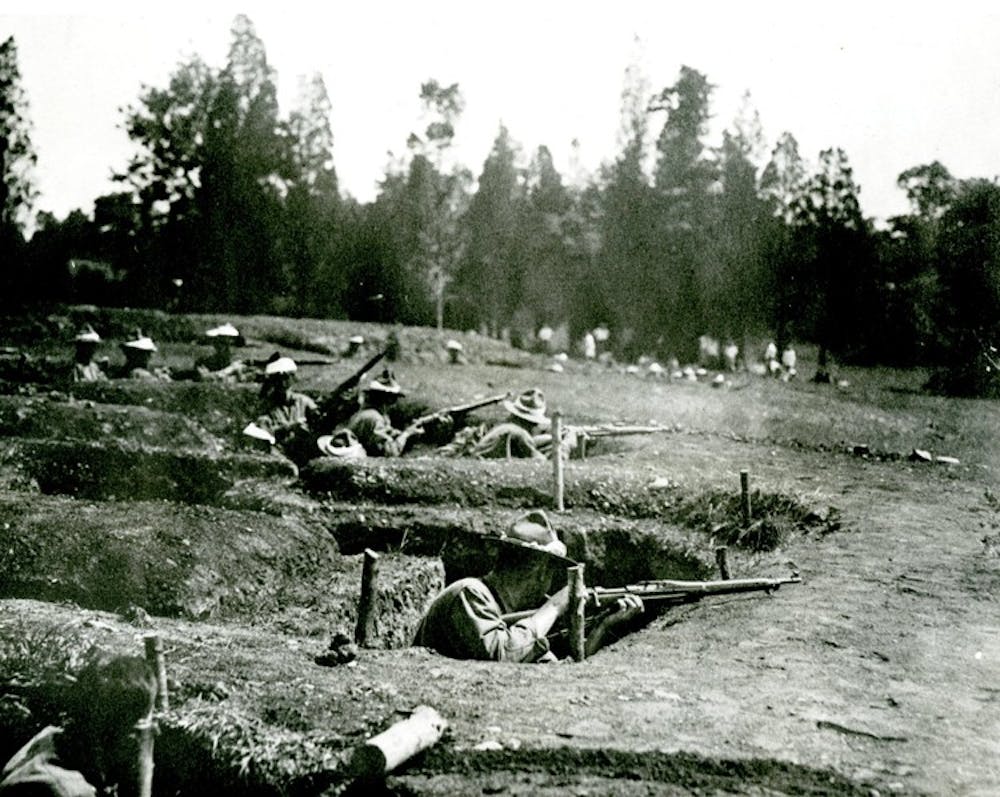This story is the second in a series investigating World War I-era chemical weapons and equipment buried under AU’s campus and in the Spring Valley neighborhood.
The Mary Graydon Center once housed the U.S. government’s largest chemical warfare research lab.
The lab, then known as the New Chemical Research building, was part of the U.S. Army’s Chemical Warfare Service branch.
The entire campus made up one of the world’s largest chemical warfare research labs.
The service began research at AU in 1917, in response to the Germans’ use of chlorine and tear gas against English and Russian soldiers at the beginning of World War I. Thousands of government-employed chemists developed defensive and offensive materials, all on AU’s campus. The U.S. government constructed more than a hundred buildings on its new property, including in MGC.
The service manufactured smoke screens, gas bombs, “flaming guns,” projectiles filled with explosive and incendiary material and many more types of weapons, AU’s newspaper, The Courier, said in an October 1918 issue.
The Boston Transcript, a daily Massachusetts newspaper, said such cruel weapons were unusual for the American military.
“The American preference would incline toward the use of a gas that would stupefy and not kill or poison, but the Germans have set the pace and the practical officers of the Army realize that their fire must be fought with hotter fire,” according to a October 1918 Courier reprint of a Boston Transcript story.
About 100,000 engineers were trained at AU during World War I.
The Chemical Warfare Service taught these men to use deadly inventions and defensive equipment on the battlefield. The men learned how to use gas masks, a cutting-edge invention that would later help the U.S. and its allies.
The Boston Transcript wrote an account of the war preparations taking place at AU.
“If His Satanic Majesty [Satan] happened to drop around at the American University training camp to-day, he would see the ‘Hell Fire Battalion’ at work and might blush with envy,” The Transcript wrote.
The “Hell Fire Battalion” was officially named the “Gas and Flame Regiment,” the first of its kind and one of Camp American University’s specialties.
A local newspaper, The Baltimore Evening Star, visited the campus in 1918.
“Gas and flame fighting is a new wrinkle in the American Army, but the ‘Hell Fire Battalion’ has taken to it as the duck takes to water,” The Evening Star wrote. “It offers more possibilities of adventure and action than any other branch of the service.”
A member of the Gas and Flame Regiment, Lieutenant Thomas Jabine, wrote about his experience in a letter he sent home.
“Our regiment is growing larger every day and the 30th Engineers ‘Gas and Flame’ is going to be an outfit that will make a reputation for itself,” Jabine wrote in November 1917. “I think I was fortunate enough to get in and glad I decided just when I did.”
Jabine and half of the first Gas and Flame regiment were shipped to Europe on Christmas Day, 1917.
After training with British soldiers, they traveled to the front lines in France where they fought off German attacks. The Boston Transcript said the American and British forces put on “shows” of their chemical weapon expertise, but suffered very real injuries.
“Their risks were real enough to result in three or four casualties from machine-gun or shell-fire and 14 or 15 more from gas, even before they had pulled off any ‘shows,’” historian James Thayer Addison wrote in 1919.
But, according to one Army engineer, what the “Hell Fire Battalion” left behind at AU was even more deadly than the Germans’ chemical weapons.
See the third part of this series in The Eagle’s March 22 issue.
news@theeagleonline.com
From The University Courier, April 1919 issue: “The University is Still Open”
• “We have been frequently asked, has the occupation of the University grounds and buildings by the United States Government closed the school? It would seem so to the persons who drive by the institution. At one time nearly or quite 300 of the war workers in the Gas Service had signed applications to matriculate in the University as post-graduate students ... ”
• “While the class rooms in the College of History building have been occupied by the Government offices, recitations have had to be taken to the homes of instructors, or elsewhere in the city. The Extension Lectures have also been given in the city, several of the churches continuing to open their doors for this purpose.”
Courses offered during the war:
• Assyriology • Egyptology • Church History • Philosophy • International and Canon Law • Physics • Agricultural Chemistry • English History





